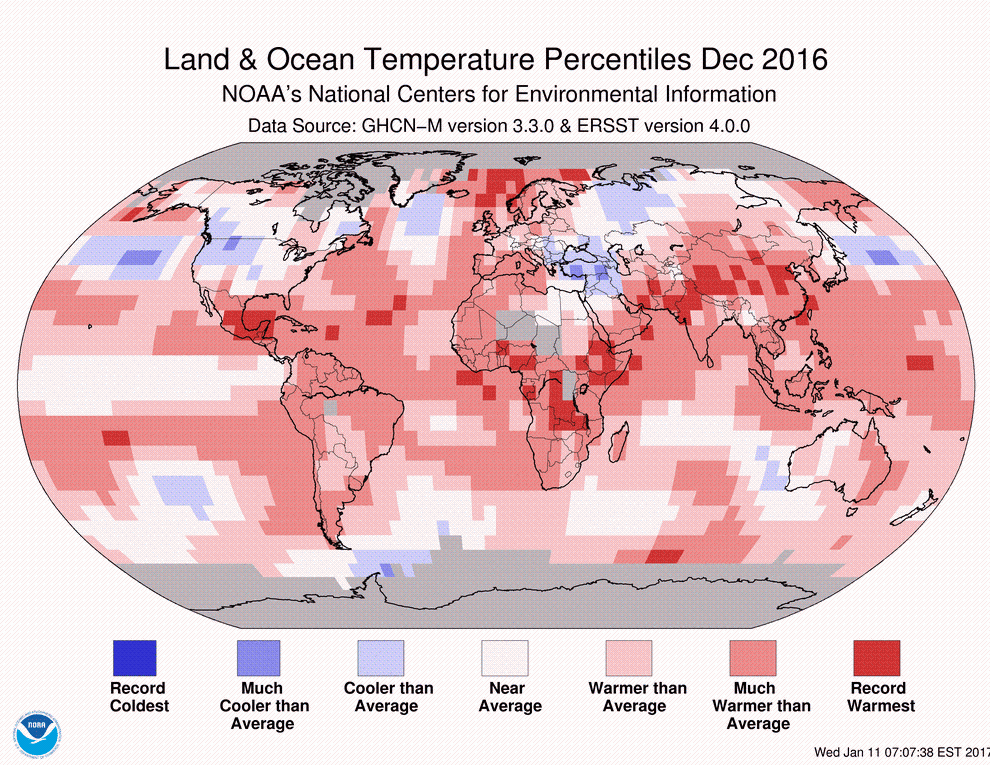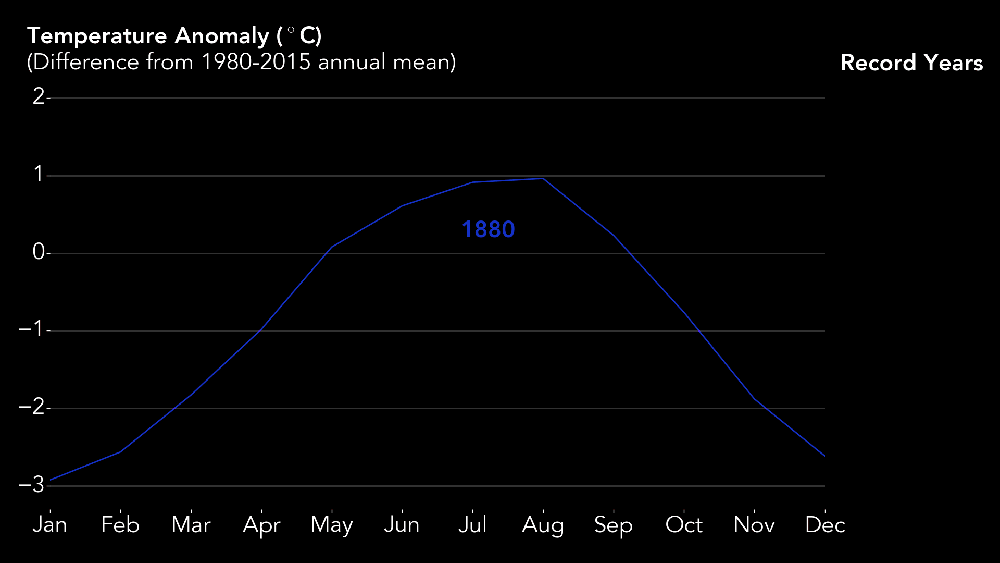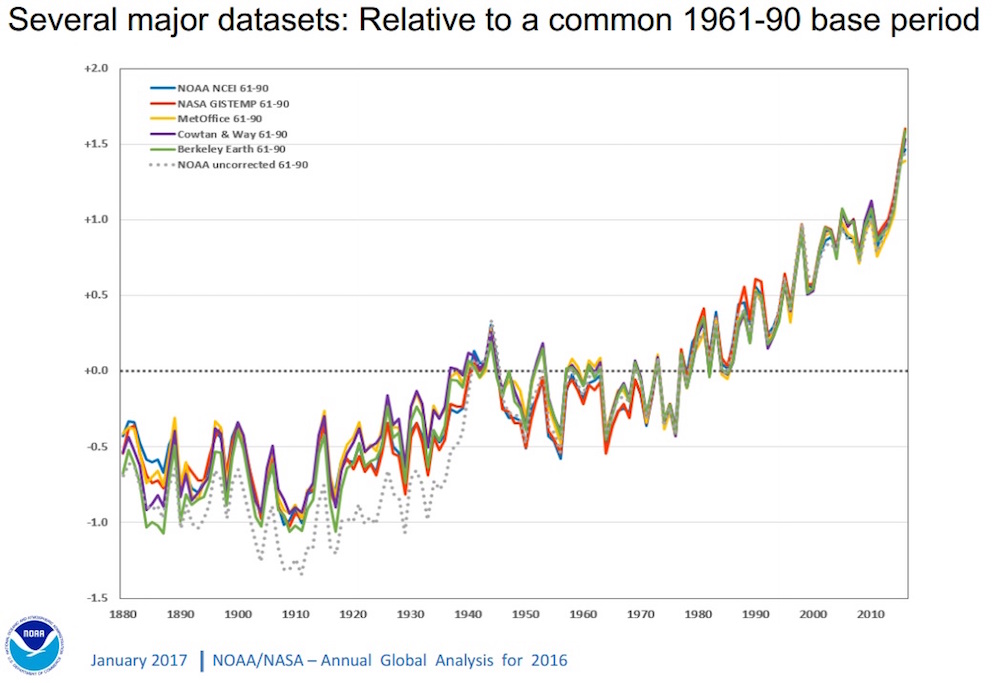2016 Was Earth's Hottest Year on Record, and Humans Are to Blame

Updated at 3:02 p.m. ET.
2016 was the hottest year on Earth since record keeping began more than 130 years ago, and humans are mostly to blame, scientists reported today (Jan. 18).
Last year's average temperatures over land and sea surfaces were the highest ever seen since 1880, and were 1.69 degrees Fahrenheit (0.94 degrees Celsius) above the 20th-century average, according to scientists from the National Oceanic and Atmospheric Administration (NOAA). Across the planet, there was not a single land area that experienced lower-than-average temperatures for the year, they said.
In fact, 2016 marks the third consecutive record-warm year for the globe. Every month from January through August became the warmest such month on record, according to NOAA. Moreover, the 16 successive months from May 2015 to August 2016 either broke or tied the previous record for that month, the researchers said.
"This was the third year in a row in our analysis to set a new record," Deke Arndt, chief of the global monitoring branch at NOAA's National Centers for Environmental Information in Asheville, North Carolina, told reporters today. "That happened only once before in our record, and that was in the years 1939 through 1941, which now don't even fit in the top 30 [hottest years] of the record." [The Year in Climate Change: 2016's Most Depressing Stories]
The poles are also feeling the heat. An estimate of the average annual sea-ice extent in 2016 in the Arctic was the lowest annual average on record: 3.92 million square miles (10.1 million square kilometers), according to the National Snow and Ice Data Center.
"You can see 2016 certainly scraped the bottom of this record, and at times, especially during the Northern Hemisphere's spring months and in the last two-and-a-half months of the year, set new records for small sea-ice extent," Arndt said.
Get the Space.com Newsletter
Breaking space news, the latest updates on rocket launches, skywatching events and more!

Meanwhile, the Arctic was almost 7.2 degrees F (4 degrees C) warmer in 2016 than it was in preindustrial times, said Gavin Schmidt, director of NASA's Goddard Institute for Space Studies. "That's really a very large change," he said.
The El Niño (a climate cycle characterized by unusually warm temperatures in the equatorial Pacific Ocean) that spanned 2015 and 2016 contributed to the warmer temperatures, but the vast majority of the warming — 90 percent — was due to human activity, mainly through the emission of greenhouse gases, Schmidt said.
The researchers noted that they used global climate models to determine how different factors — including the natural impacts of volcanoes, solar changes and variations in Earth's orbit, as well as human-related impacts, such as greenhouse gases — contributed to climate change.
"We find the individual fingerprints for all of those different things," Schmidt said. "And then we look at all of the data sets — not just the surface air temperatures, but the data sets from the upper atmosphere and stratosphere and the deep ocean."
These models show that over time, the natural-component contribution to the record warmth "is very close to zero," Schmidt said. "Pretty much all of the long-term trend that you're seeing is the result of human activity, and the dominant part of that is the increase in greenhouse gases, particularly carbon dioxide."
In addition to looking at NASA and NOAA data, the researchers analyzed global temperature data sets from three other sources: the United Kingdom's Met Office; an adaptation of the Met Office's data set from researchers Kevin Cowtan, a chemist at the University of York, and Robert Way, a doctoral student of geography at the University of Ottawa; and temperature data from the California-based independent nonprofit organization Berkeley Earth. [Earth in the Balance: 7 Crucial Tipping Points]
The analyses have slight differences from year to year, but "they are capturing the same long-term signal" that the planet is warming rapidly, Arndt said. "I like to say that these data sets are all singing the same song, even if they're hitting different notes along the way," Arndt noted. "The pattern is very clear."

The researchers declined to say whether the newly released data had a takeaway for the incoming administration of President-elect Donald Trump, who takes office this Friday (Jan. 20).
"We provide these assessments and these analyses for the benefit of the American people," Arndt said. "Our mission is strictly to describe the state of the climate and our methods on how we got there."
Original article on Live Science.
Join our Space Forums to keep talking space on the latest missions, night sky and more! And if you have a news tip, correction or comment, let us know at: community@space.com.

Laura is an editor at Live Science. She edits Life's Little Mysteries and reports on general science, including archaeology and animals. Her work has appeared in The New York Times, Scholastic, Popular Science and Spectrum, a site on autism research. She has won multiple awards from the Society of Professional Journalists and the Washington Newspaper Publishers Association for her reporting at a weekly newspaper near Seattle. Laura holds a bachelor's degree in English literature and psychology from Washington University in St. Louis and an advanced certificate in science writing from NYU.










